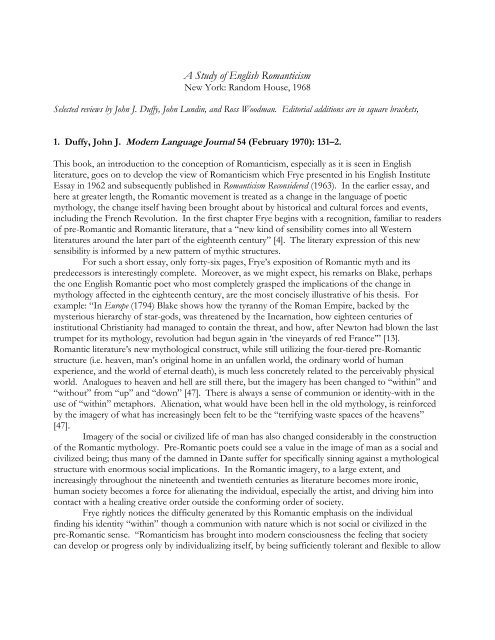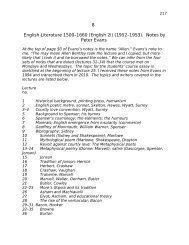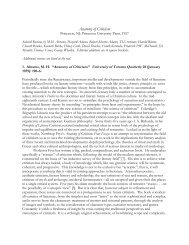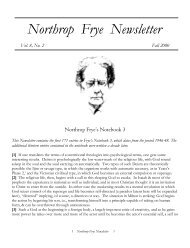A Study of English Romanticism (pdf)
A Study of English Romanticism (pdf)
A Study of English Romanticism (pdf)
Create successful ePaper yourself
Turn your PDF publications into a flip-book with our unique Google optimized e-Paper software.
A <strong>Study</strong> <strong>of</strong> <strong>English</strong> <strong>Romanticism</strong><br />
New York: Random House, 1968<br />
Selected reviews by John J. Duffy, John Lundin, and Ross Woodman. Editorial additions are in square brackets,<br />
1. Duffy, John J. Modern Language Journal 54 (February 1970): 131–2.<br />
This book, an introduction to the conception <strong>of</strong> <strong>Romanticism</strong>, especially as it is seen in <strong>English</strong><br />
literature, goes on to develop the view <strong>of</strong> <strong>Romanticism</strong> which Frye presented in his <strong>English</strong> Institute<br />
Essay in 1962 and subsequently published in <strong>Romanticism</strong> Reconsidered (1963). In the earlier essay, and<br />
here at greater length, the Romantic movement is treated as a change in the language <strong>of</strong> poetic<br />
mythology, the change itself having been brought about by historical and cultural forces and events,<br />
including the French Revolution. In the first chapter Frye begins with a recognition, familiar to readers<br />
<strong>of</strong> pre-Romantic and Romantic literature, that a “new kind <strong>of</strong> sensibility comes into all Western<br />
literatures around the later part <strong>of</strong> the eighteenth century” [4]. The literary expression <strong>of</strong> this new<br />
sensibility is informed by a new pattern <strong>of</strong> mythic structures.<br />
For such a short essay, only forty-six pages, Frye’s exposition <strong>of</strong> Romantic myth and its<br />
predecessors is interestingly complete. Moreover, as we might expect, his remarks on Blake, perhaps<br />
the one <strong>English</strong> Romantic poet who most completely grasped the implications <strong>of</strong> the change in<br />
mythology affected in the eighteenth century, are the most concisely illustrative <strong>of</strong> his thesis. For<br />
example: “In Europe (1794) Blake shows how the tyranny <strong>of</strong> the Roman Empire, backed by the<br />
mysterious hierarchy <strong>of</strong> star-gods, was threatened by the Incarnation, how eighteen centuries <strong>of</strong><br />
institutional Christianity had managed to contain the threat, and how, after Newton had blown the last<br />
trumpet for its mythology, revolution had begun again in ‘the vineyards <strong>of</strong> red France’” [13].<br />
Romantic literature’s new mythological construct, while still utilizing the four-tiered pre-Romantic<br />
structure (i.e. heaven, man’s original home in an unfallen world, the ordinary world <strong>of</strong> human<br />
experience, and the world <strong>of</strong> eternal death), is much less concretely related to the perceivably physical<br />
world. Analogues to heaven and hell are still there, but the imagery has been changed to “within” and<br />
“without” from “up” and “down” [47]. There is always a sense <strong>of</strong> communion or identity-with in the<br />
use <strong>of</strong> “within” metaphors. Alienation, what would have been hell in the old mythology, is reinforced<br />
by the imagery <strong>of</strong> what has increasingly been felt to be the “terrifying waste spaces <strong>of</strong> the heavens”<br />
[47].<br />
Imagery <strong>of</strong> the social or civilized life <strong>of</strong> man has also changed considerably in the construction<br />
<strong>of</strong> the Romantic mythology. Pre-Romantic poets could see a value in the image <strong>of</strong> man as a social and<br />
civilized being; thus many <strong>of</strong> the damned in Dante suffer for specifically sinning against a mythological<br />
structure with enormous social implications. In the Romantic imagery, to a large extent, and<br />
increasingly throughout the nineteenth and twentieth centuries as literature becomes more ironic,<br />
human society becomes a force for alienating the individual, especially the artist, and driving him into<br />
contact with a healing creative order outside the conforming order <strong>of</strong> society.<br />
Frye rightly notices the difficulty generated by this Romantic emphasis on the individual<br />
finding his identity “within” though a communion with nature which is not social or civilized in the<br />
pre-Romantic sense. “<strong>Romanticism</strong> has brought into modern consciousness the feeling that society<br />
can develop or progress only by individualizing itself, by being sufficiently tolerant and flexible to allow
an individual to find his own identity within it, even though in doing so he comes to repudiate most <strong>of</strong><br />
the conventional values <strong>of</strong> society” [48].<br />
This residual anarchism, a principle at the very heart <strong>of</strong> the Romantic movement, continues to exert<br />
itself. The dreadful irony, <strong>of</strong> course, is that the political bodies <strong>of</strong> society—in Eastern and Western<br />
Europe and the Americas, as well as parts <strong>of</strong> Asia and Africa—which are based on political principles<br />
and programs <strong>of</strong> the social action ultimately derived from aspects <strong>of</strong> Romantic mythology, continue to<br />
try to suppress it.<br />
The three essays in this book on Beddoes’ Death’s Jest Book, Shelley’s Prometheus Unbound, and<br />
Keats’ Endymion are meant to be illustrative <strong>of</strong> Frye’s thesis <strong>of</strong> a change in the language <strong>of</strong> poetic<br />
mythology as the principle feature <strong>of</strong> the Romantic movement. While they are all argued pieces <strong>of</strong><br />
work, carefully analytical studies, there remains always present Frye’s sense <strong>of</strong> the essential virtue <strong>of</strong> the<br />
Romantic poets: that they “preserve the feeling that at the heart <strong>of</strong> the best and fullest life is something<br />
anti-social, or more accurately something beyond society which is still essential to human identity”<br />
[163-64].<br />
2. Lundin, John . Studia Neophilologica 43, no. 2 (1971): 590–3.<br />
At present Northrop Frye is among the best-known and most widely influential <strong>of</strong> North American<br />
critics, well on his way apparently to becoming something <strong>of</strong> a twentieth century classic; the decision <strong>of</strong><br />
the <strong>English</strong> Institute in America to devote an entire conference to assessing the significance <strong>of</strong> his<br />
work is perhaps the clearest evidence <strong>of</strong> his stature today among his colleagues, an unusual honor for a<br />
critic in any event, and a highly unusual one in the case <strong>of</strong> a writer at the height <strong>of</strong> his career.<br />
This book, which had its start as a series <strong>of</strong> lectures at Western Reserve University is based on<br />
ideas outlined in an earlier study, <strong>Romanticism</strong> Reconsidered (1963), and anyone familiar with Frye’s<br />
criticism will recognize the same mythopoeic interests which have absorbed much <strong>of</strong> his attention in<br />
the past, the emphasis on archetypes and spatial levels <strong>of</strong> myth, the same concern with identifying in<br />
poetry the imaginative constructions governing the writer’s mental habits and choice <strong>of</strong> motifs; he sets<br />
out to understand <strong>Romanticism</strong> as it relates to the first important change in the pattern <strong>of</strong> mythology<br />
<strong>of</strong> Western Europe, whose encyclopedic structure, primarily Biblical in origin, dominated both its<br />
literary and philosophical traditions down to the middle <strong>of</strong> the eighteenth century. It is always difficult<br />
to summarize Frye without resorting to his terminology, so that it seems wisest to let him speak for<br />
himself whenever possible. Thus, in a resume <strong>of</strong> the first chapter, he explains the “four-tiered<br />
structure” <strong>of</strong> Christian mythology which <strong>Romanticism</strong> eventually replaces: “These four levels are<br />
heaven, the unfallen world which is man’s original and proper home, the ordinary world <strong>of</strong> experience,<br />
and the demonic world <strong>of</strong> eternal death. In this schema there are two principles involved, one cyclical<br />
and the other dialectical. The two levels <strong>of</strong> nature in the middle are related cyclically: imagery <strong>of</strong><br />
fertility, youth and perpetual spring, and gardens <strong>of</strong> flourishing trees and flowing water describe the<br />
world man fell from at the beginning <strong>of</strong> the cycle <strong>of</strong> history, and to which he should return at the end<br />
<strong>of</strong> it. Heaven and hell, on the other hand, are worlds <strong>of</strong> eternal separation, one being a community <strong>of</strong><br />
identity and the other a pseudo-community <strong>of</strong> alienation. These two worlds are normally, in poetic<br />
imagery, ‘up’ and ‘down,’ associated respectively with the starry skies and the underground world <strong>of</strong> the<br />
dead” [46]. According to Frye, Romantic myth assumes the same hierarchy <strong>of</strong> values, but in a way<br />
which is less concerned with explaining the ordinary physical world <strong>of</strong> perception, more with selfconsciousness<br />
as it is separated or isolated from nature. The ideas <strong>of</strong> heaven and hell (identity and<br />
alienation) are still important in the new mythology. Now, however, the fundamental opposition in<br />
poetic imagery is between a subjective state, usually a communion with nature or God, and a sense <strong>of</strong><br />
externality (“within” and “without”); whereas the traditional metaphors in Christianity for the passage<br />
<strong>of</strong> the soul are ascending ones, the romantic search for identity tends increasingly to be “downward<br />
2
and inward.” The gradual breaking out <strong>of</strong> myth <strong>of</strong> the sciences forces the realization that the<br />
prevailing views <strong>of</strong> the universe are poetic in nature: the chief consequence for the artist is an altered<br />
conception <strong>of</strong> his own role (what Frye calls a “recovery <strong>of</strong> projection” [14]), the realization that man<br />
creates the forms <strong>of</strong> his culture and is responsible for his own destiny. As elsewhere in his writings<br />
Frye concerns himself with the concept <strong>of</strong> the hero as the embodiment <strong>of</strong> myth, devoting space to an<br />
examination <strong>of</strong> the romantic prototypes in their various mutations: the solitary, the wanderer, the exile,<br />
the struggle-<strong>of</strong>-brothers theme, and so on.<br />
To present Frye’s remarks piecemeal in this manner, I am afraid, is to make them sound<br />
commonplace, which is not at all true <strong>of</strong> this challenging book. Admittedly, there is nothing<br />
particularly new in the ideas outlined here: but Frye is above all a diagramist—he has a synthesizing<br />
imagination which works in large conceptual patterns—and his originality consists in the way that he<br />
manipulates the elements <strong>of</strong> his schema rather than the elements themselves. He challenges us by<br />
making us think in historical terms and by refusing to be limited by the usual categories <strong>of</strong> literature;<br />
above all because he is so well-equipped to pursue ritualized artistic forms through their evolution.<br />
The pleasure <strong>of</strong> reading Frye is a pleasure in the richness <strong>of</strong> his recall, the interlacing associations in his<br />
mind. He refers most frequently to Blake, Shakespeare, and Eliot (Blake is one <strong>of</strong> the principle<br />
influences on his own thinking), since he knows them best; but the range <strong>of</strong> his knowledge is<br />
impressive: Whitman, Rilke, Zen, the Bhagavadgita, Chatterton, Horace, Heidegger, Japanese haiku,<br />
Bosch, Wagner, Apuleius, Berkely, Teihard de Chardin, Ovid, Proust, Rousseau, Maeterlinck, Pound,<br />
Yeats—references that cut across the familiar boundaries <strong>of</strong> time, language, and genre, drawn together<br />
by an imagination moving freely over his material. That such a method ultimately tells us as much<br />
about its author as it does about its subject is a consequence which has been foreseen and apparently<br />
accepted by Frye: [As he says elsewhere], “It is the systematic thinker, not the introspective thinker,<br />
who most fully reveals his mind in process, and so most clearly illustrates how he arrives at his<br />
conclusions.” Let us be clear that Frye’s mythopoeic inductions are generally convincing in so far that<br />
one accepts the premises on which they are based and can sympathize with his approach. The Anatomy<br />
<strong>of</strong> Criticism after all, in spite <strong>of</strong> its influence, remains very much <strong>of</strong> a controversial work.<br />
Both the advantages and limitations <strong>of</strong> the Fryean system can be seen in the three chapters<br />
which follow his discussion <strong>of</strong> “The Romantic Myth”: Beddoes’ Death’s Jest-Book, Shelley’s Prometheus<br />
Unbound, and Keats’ Endymion are selected for special attention, with the somewhat gratuitous<br />
suggestion in the introduction that “this is not a book on Beddoes or Keats or Shelley, but a book on<br />
<strong>Romanticism</strong> as illustrated by some <strong>of</strong> their works” [v-vi]. “Interpenetrate” is a term, one should<br />
perhaps say a concept, that Frye has shown himself much addicted to in the past. He speaks <strong>of</strong><br />
literature as a field <strong>of</strong> “interpenetrating visions,” <strong>of</strong> value judgments in criticism that “interpenetrate”<br />
with one another; and it is the notion <strong>of</strong> an interpenetrating world <strong>of</strong> life and death, nature and<br />
humanity (he locates the expression in Keats’ letters and The Defence <strong>of</strong> Poetry) which runs through these<br />
chapters and joins them together. Beddoes is studied for his preoccupation with the opposition <strong>of</strong><br />
love and death; Shelley is treated in terms <strong>of</strong> the idea <strong>of</strong> the recovery <strong>of</strong> man’s myth-making powers, its<br />
liberating, regenerating effects on consciousness; Keats becomes the focus <strong>of</strong> the myth <strong>of</strong> the divinity<br />
<strong>of</strong> the creative spirit. Lack <strong>of</strong> space prevents me from looking equally at each <strong>of</strong> the chapters, and I<br />
must confine myself to the first, in some ways the most interesting <strong>of</strong> the three. It is worth noticing in<br />
the bibliography at the end <strong>of</strong> this study, which provides a list <strong>of</strong> recent publications dealing with the<br />
symbolism and mythology <strong>of</strong> romanticism, that there is not a single book which concentrates<br />
specifically on Beddoes, and only three which are concerned with him at all. Yet Frye refers to him as<br />
a major romantic poet and devotes as much space to an interpretation <strong>of</strong> Death’s Jest-Book as he does to<br />
either Endymion or Prometheus Unbound.<br />
It is to Frye’s credit that in treating <strong>of</strong> Beddoes he shows himself oblivious to the aura <strong>of</strong><br />
morbidity which has always accompanied the poet’s reputation, and his chapter, “Yorick: The<br />
3
Romantic Macabre,” would be worthy <strong>of</strong> attention if for no other reason than that he discusses<br />
Beddoes’ interest in death solely in terms <strong>of</strong> its thematic expression, unconcerned with questions <strong>of</strong><br />
sensationalism. Death’s Jest-Book, written as a kind <strong>of</strong> interior monologue, a metaphysical poem akin to<br />
the second part <strong>of</strong> Faust, is well-suited to such an approach, especially by a critic <strong>of</strong> Frye’s powers <strong>of</strong><br />
sympathy. Beddoes’ association <strong>of</strong> love and death, Eros and Thanatos, he proposes, is a manifestation<br />
<strong>of</strong> an isolated consciousness whose union with nature comes only as a result <strong>of</strong> a loss <strong>of</strong> being: the<br />
perennial theme in literature <strong>of</strong> the crisis <strong>of</strong> identity at the moment <strong>of</strong> death is transformed into a<br />
constant process, where every moment becomes a moment <strong>of</strong> death, where life and death are different<br />
aspects <strong>of</strong> the same world. There have been earlier references to Beddoes’ “modern temper,” his<br />
relation to Büchner and Poe, but is has taken Frye to forge a link between his speculations on the<br />
nature <strong>of</strong> identity, his concept <strong>of</strong> the grotesque and antiheroic condition <strong>of</strong> life embodied in Death’s<br />
Jest-Book, and the twentieth century Theater <strong>of</strong> the Absurd. Alone among the romantics, Beddoes<br />
possesses a “distinctively modern quality <strong>of</strong> fantasy” [63], for when life interpenetrates with death, so<br />
does sanity with insanity, waking with dreaming. No one before Frye has characterized Beddoes’<br />
originality in terms <strong>of</strong> his identification <strong>of</strong> the noumenal world with death and his absurd conception<br />
<strong>of</strong> its visible forms: “What Beddoes contributes to <strong>Romanticism</strong> is, perhaps, the most complete and<br />
searching poetic reaction to the Romantic sense <strong>of</strong> the limitations <strong>of</strong> ordinary experience” [84]. Frye is<br />
nothing if not provocative, and his work contains a number <strong>of</strong> interesting suggestions; but his<br />
fondness for generalizing sometimes leads him astray. By and large he claims for Death’s Jest-Book a<br />
level <strong>of</strong> technical competence that not even its author would have admitted. I cannot agree, for<br />
instance, that the Duke is a “marvellous creation, very like the successful rulers <strong>of</strong> Shakespeare” [70];<br />
nor do I believe, as he does, that the “movement <strong>of</strong> spasmodic and galvanized action” [64] <strong>of</strong> the<br />
characters is part <strong>of</strong> Beddoes’ conception <strong>of</strong> the play, but would rather attribute it to his inability to<br />
realize them as living personages and give them an existence apart from himself. One <strong>of</strong> the things<br />
that is irritating about this book is Frye’s tendency to stretch a generalization to the extreme for the<br />
sake <strong>of</strong> an insight, leaving us undecided as to whether it is a shrewd suggestion or merely in need <strong>of</strong><br />
more careful elaboration. “All genuine humor in one sense is gallows humor,” he says in a discussion<br />
<strong>of</strong> Beddoes’ use <strong>of</strong> the grotesque, “because humor begins in the accepting <strong>of</strong> the limits <strong>of</strong> the human<br />
condition” [62]. We do not know exactly what he means by “genuine”; here the qualifying phrase “in<br />
one sense” (as elsewhere “up to a point,” “to a certain extent”) appear to let him <strong>of</strong>f the hook.<br />
Moreover, his concept <strong>of</strong> the grotesque, the tragicomic vision <strong>of</strong> Death’s Jest-Book which is central to<br />
the argument <strong>of</strong> the chapter, is so narrowly defined in respect to Beddoes’ own view <strong>of</strong> the<br />
simultaneity <strong>of</strong> life and death that its general meaning never emerges. Frye’s main illustration seems to<br />
shield a non sequitur: “Ghosts, for example, are at once alive and dead, and so inspire the kind <strong>of</strong><br />
hysteria that is expressed equally by horror and laughter” [60]. If in weaving a fabric out <strong>of</strong> isolated<br />
quotations Frye inevitably lacks a certain concreteness, he is never very wide <strong>of</strong> the mark; and his<br />
distance from his subject has the positive advantage <strong>of</strong> allowing him to visualize the ideological<br />
patterns which are his primary strength.<br />
3. Woodman, Ross. University <strong>of</strong> Toronto Quarterly 38 (July 1969): 371–3.<br />
Northrop Frye’s debt to William Blake is writ large in his major contribution to a theory <strong>of</strong> literature,<br />
Anatomy <strong>of</strong> Criticism. In his reading <strong>of</strong> William Blake he made certain significant discoveries about the<br />
reading <strong>of</strong> all literature, discoveries that subsequently allowed him to range more freely and more<br />
assuredly than any other literary theorist, either <strong>of</strong> the past or <strong>of</strong> the present, over the entire field <strong>of</strong><br />
literature. Though some scholars have taken exception to his freedom and his assurance, particularly<br />
when brought to bear on their specialized domains, few, if any, have questioned his right and his ability<br />
4
to interpret <strong>English</strong> <strong>Romanticism</strong>. Frye’s reputations was established initially in the field <strong>of</strong><br />
<strong>Romanticism</strong> when in 1947 he published Fearful Symmetry, and it is therefore a source <strong>of</strong> enormous<br />
pleasure to his admirers (as will perhaps as a source <strong>of</strong> considerable relief to his critics) to find him in<br />
A <strong>Study</strong> <strong>of</strong> <strong>English</strong> <strong>Romanticism</strong> returning from studies <strong>of</strong> Eliot and Shakespeare (among others) to a<br />
subject which in so many respects is the true object <strong>of</strong> his impressive knowledge.<br />
One <strong>of</strong> the great virtues <strong>of</strong> Frye’s theoretical and descriptive approach to literature is the way in<br />
which it brings into focus works that have been largely overlooked, partly at least “The Romantic<br />
Myth” (which grew out <strong>of</strong> his penetrating essay, “The Drunken Boat,” published in <strong>Romanticism</strong><br />
Reconsidered), Frye turns to Thomas Lovell Beddoes’ Death’s Jest-Book and firmly for the first time<br />
integrates it into a study <strong>of</strong> <strong>Romanticism</strong>. What in the partial and distorting gaze <strong>of</strong> lesser critics was<br />
passed <strong>of</strong>f (or over) as “morbid” becomes, under his expert, more comprehensive, scrutiny, the<br />
embodiment <strong>of</strong> the “tragicomic grotesque” [60]. Frye argues that the grotesque is rooted in “the sense<br />
<strong>of</strong> the simultaneous presence <strong>of</strong> life and death” [60]; what is essentially “tragicomic” about Beddoes’<br />
treatment <strong>of</strong> it is his recognition <strong>of</strong> the presence <strong>of</strong> death in the midst <strong>of</strong> life, <strong>of</strong> death as the goal <strong>of</strong><br />
life, interpenetrating it and conducting through knowledge toward it. Frye thus isolates what he<br />
considers Beddoes’ chief contribution to the study <strong>of</strong> <strong>Romanticism</strong>: a preoccupation with death as<br />
imaging, dramatizing, or adumbrating a realm <strong>of</strong> reality beyond or within the external world.<br />
In this realm, revealed by the imagination, associated with dream and articulated by myth,<br />
Beddoes moves with the kind <strong>of</strong> imaginative familiarity and ease that makes him a central, potentially<br />
major, figure in <strong>English</strong> <strong>Romanticism</strong>. By devoting a chapter to him, Frye provides Beddoes with a<br />
place alongside Shelley and Keats with whom the other two chapters are concerned. That his<br />
achievement is less than theirs is, it would appear, largely the result <strong>of</strong> Beddoes’ failure to evolve a<br />
technique central to the realization <strong>of</strong> the Romantic vision <strong>of</strong> an expanding psychic awareness. In his<br />
chapter on Shelley, Frye explores Shelley’s progress toward a “definitive poem” [110] in terms <strong>of</strong> a<br />
movement toward “the plotless and actionless narrative which seems to be characteristic <strong>of</strong> the<br />
mythopoeic genre” [110]. This kind <strong>of</strong> narrative, realized in Prometheus Unbound, is absent in Death’s<br />
Jest-Book. “In Death’s Jest-Book,” writes Frye, “one has the feeling that the complex plot is not the<br />
inevitable form <strong>of</strong> what Beddoes has to say, but a separable artefact, and that he did not sufficiently<br />
realize that the plot was an obstacle to his dramatic utterance” [69]. The plot in Death’s Jest-Book is<br />
rather like the plot in Shelley’s The Revolt <strong>of</strong> Islam: “a great nuisance” [110], to quote Frye.<br />
Frye points out that Beddoes postponed the publication <strong>of</strong> his drama because he wished to<br />
make it real stage play to be acted in the theater. At he same time, however, in his revisions, he paid<br />
greater and greater attention to the lyrical element. It would therefore appear that, unlike Shelley<br />
writing his “lyrical drama” for “the more select classes <strong>of</strong> poetical readers,” Beddoes was<br />
simultaneously moving in two opposing directions which prevented his from realizing the form<br />
inherent in his theme. “But he was a poet <strong>of</strong> brilliant fragments and powerfully suggestive torsos <strong>of</strong><br />
unfinished plays” [67]. Frye concludes.<br />
The vantage point from which Frye writes allow him to discern, sometimes too clearly perhaps,<br />
a body emergent in “brilliant fragments.” In his conclusion to his chapter on Keats, he assets as a<br />
general principle that “no poetry <strong>of</strong> high intensity covers a part only <strong>of</strong> the imaginative world; it covers<br />
its entire range, by implication at least” [164]. This means, among other things, that “in the course <strong>of</strong><br />
time [Keats’] written poetry becomes also, for us, what his unwritten poetry would have been” [164].<br />
The critic truly to discern what is there “by implication” must recognize the voice <strong>of</strong> prophecy present<br />
in poetry <strong>of</strong> “high intensity.” By prophecy I mean, <strong>of</strong> course, not some occult foretelling <strong>of</strong> future<br />
events, but the perception <strong>of</strong> the total form <strong>of</strong> the human experience in any particular manifestation <strong>of</strong><br />
it. Frye found this view <strong>of</strong> the poet as prophet in Blake even as, like Blake, he found it in the inspired<br />
literature <strong>of</strong> the Old Testament. Something <strong>of</strong> that same visionary power inherent in the Romantic<br />
conception <strong>of</strong> the poet as prophet is present also in Frye. The critic who went to school with Blake<br />
5
has, <strong>of</strong> course, his limitations. Where perhaps they are least likely to show up is in a study <strong>of</strong> the<br />
visionary world shaped by the Romantic imagination.<br />
Another Review<br />
Hashiguchi, Minoru. “Northrop Frye and <strong>Romanticism</strong>.” Eigo seinen [The Rising Generation] 116 (April<br />
1970): 49. In Japanese.<br />
6





